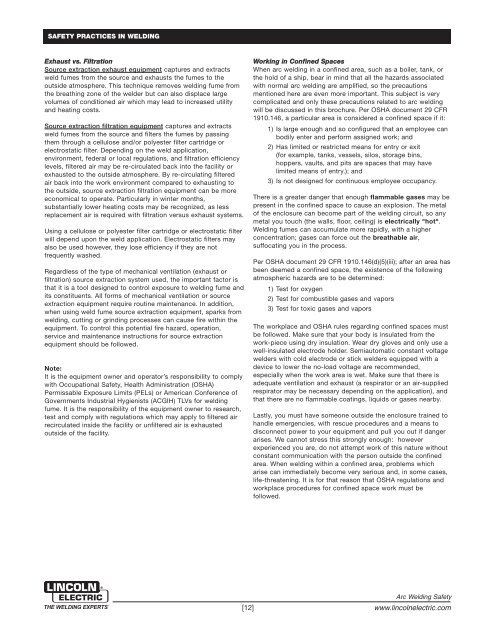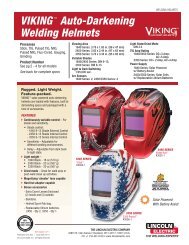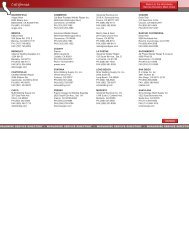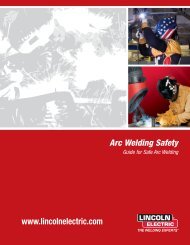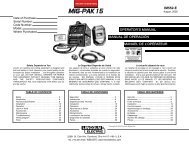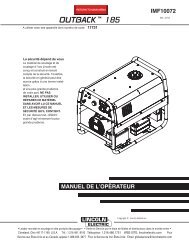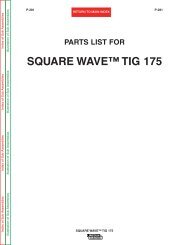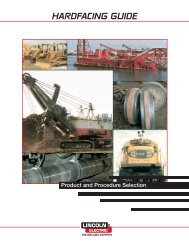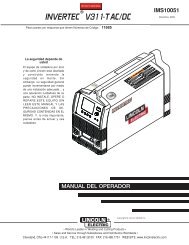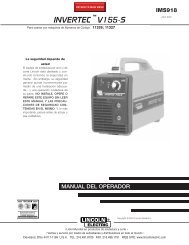E205 Arc Welding Safety - Lincoln Electric
E205 Arc Welding Safety - Lincoln Electric
E205 Arc Welding Safety - Lincoln Electric
You also want an ePaper? Increase the reach of your titles
YUMPU automatically turns print PDFs into web optimized ePapers that Google loves.
SAFETY PRACTICES IN WELDING<br />
Exhaust vs. Filtration<br />
Source extraction exhaust equipment captures and extracts<br />
weld fumes from the source and exhausts the fumes to the<br />
outside atmosphere. This technique removes welding fume from<br />
the breathing zone of the welder but can also displace large<br />
volumes of conditioned air which may lead to increased utility<br />
and heating costs.<br />
Source extraction filtration equipment captures and extracts<br />
weld fumes from the source and filters the fumes by passing<br />
them through a cellulose and/or polyester filter cartridge or<br />
electrostatic filter. Depending on the weld application,<br />
environment, federal or local regulations, and filtration efficiency<br />
levels, filtered air may be re-circulated back into the facility or<br />
exhausted to the outside atmosphere. By re-circulating filtered<br />
air back into the work environment compared to exhausting to<br />
the outside, source extraction filtration equipment can be more<br />
economical to operate. Particularly in winter months,<br />
substantially lower heating costs may be recognized, as less<br />
replacement air is required with filtration versus exhaust systems.<br />
Using a cellulose or polyester filter cartridge or electrostatic filter<br />
will depend upon the weld application. Electrostatic filters may<br />
also be used however, they lose efficiency if they are not<br />
frequently washed.<br />
Regardless of the type of mechanical ventilation (exhaust or<br />
filtration) source extraction system used, the important factor is<br />
that it is a tool designed to control exposure to welding fume and<br />
its constituents. All forms of mechanical ventilation or source<br />
extraction equipment require routine maintenance. In addition,<br />
when using weld fume source extraction equipment, sparks from<br />
welding, cutting or grinding processes can cause fire within the<br />
equipment. To control this potential fire hazard, operation,<br />
service and maintenance instructions for source extraction<br />
equipment should be followed.<br />
Note:<br />
It is the equipment owner and operator’s responsibility to comply<br />
with Occupational <strong>Safety</strong>, Health Administration (OSHA)<br />
Permissable Exposure Limits (PELs) or American Conference of<br />
Governments Industrial Hygienists (ACGIH) TLVs for welding<br />
fume. It is the responsibility of the equipment owner to research,<br />
test and comply with regulations which may apply to filtered air<br />
recirculated inside the facility or unfiltered air is exhausted<br />
outside of the facility.<br />
[12]<br />
Working in Confined Spaces<br />
When arc welding in a confined area, such as a boiler, tank, or<br />
the hold of a ship, bear in mind that all the hazards associated<br />
with normal arc welding are amplified, so the precautions<br />
mentioned here are even more important. This subject is very<br />
complicated and only these precautions related to arc welding<br />
will be discussed in this brochure. Per OSHA document 29 CFR<br />
1910.146, a particular area is considered a confined space if it:<br />
1) Is large enough and so configured that an employee can<br />
bodily enter and perform assigned work; and<br />
2) Has limited or restricted means for entry or exit<br />
(for example, tanks, vessels, silos, storage bins,<br />
hoppers, vaults, and pits are spaces that may have<br />
limited means of entry.); and<br />
3) Is not designed for continuous employee occupancy.<br />
There is a greater danger that enough flammable gases may be<br />
present in the confined space to cause an explosion. The metal<br />
of the enclosure can become part of the welding circuit, so any<br />
metal you touch (the walls, floor, ceiling) is electrically "hot".<br />
<strong>Welding</strong> fumes can accumulate more rapidly, with a higher<br />
concentration; gases can force out the breathable air,<br />
suffocating you in the process.<br />
Per OSHA document 29 CFR 1910.146(d)(5)(iii); after an area has<br />
been deemed a confined space, the existence of the following<br />
atmospheric hazards are to be determined:<br />
1) Test for oxygen<br />
2) Test for combustible gases and vapors<br />
3) Test for toxic gases and vapors<br />
The workplace and OSHA rules regarding confined spaces must<br />
be followed. Make sure that your body is insulated from the<br />
work-piece using dry insulation. Wear dry gloves and only use a<br />
well-insulated electrode holder. Semiautomatic constant voltage<br />
welders with cold electrode or stick welders equipped with a<br />
device to lower the no-load voltage are recommended,<br />
especially when the work area is wet. Make sure that there is<br />
adequate ventilation and exhaust (a respirator or an air-supplied<br />
respirator may be necessary depending on the application), and<br />
that there are no flammable coatings, liquids or gases nearby.<br />
Lastly, you must have someone outside the enclosure trained to<br />
handle emergencies, with rescue procedures and a means to<br />
disconnect power to your equipment and pull you out if danger<br />
arises. We cannot stress this strongly enough: however<br />
experienced you are, do not attempt work of this nature without<br />
constant communication with the person outside the confined<br />
area. When welding within a confined area, problems which<br />
arise can immediately become very serious and, in some cases,<br />
life-threatening. It is for that reason that OSHA regulations and<br />
workplace procedures for confined space work must be<br />
followed.<br />
<strong>Arc</strong> <strong>Welding</strong> <strong>Safety</strong><br />
www.lincolnelectric.com


